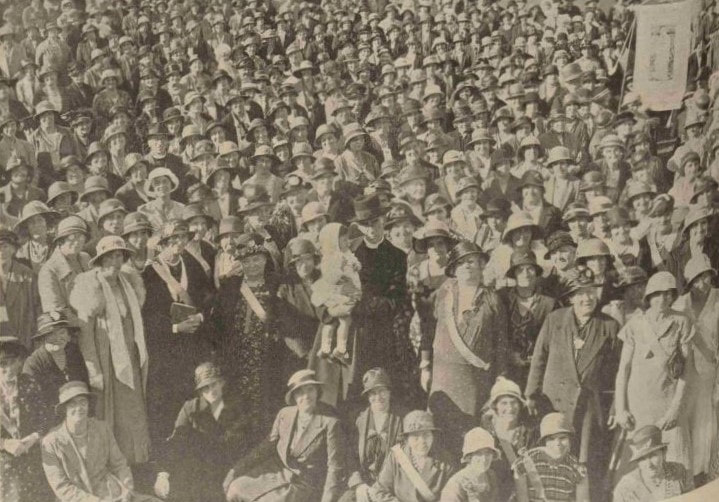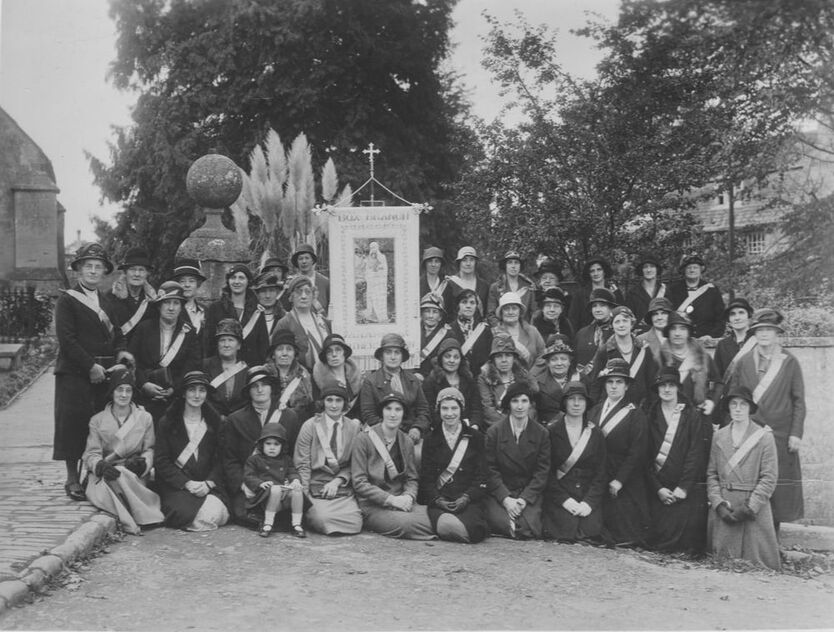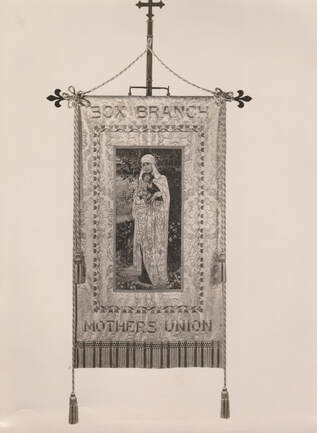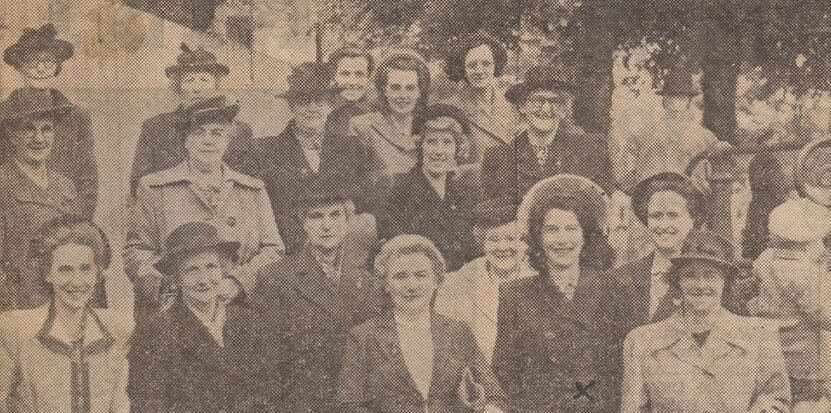Box Mothers' Union Alan Payne, Research Genevieve Horne, September 2019
The Mothers' Union was founded in the High Victorian period in 1878 by Mary Sumner, a clergyman's wife, to support her daughter in giving religious teaching and moral leadership in the home. It quickly became a national, then an international, association across the Empire after Queen Victoria became patron in 1897. It was accepted as an institutional part of the Church of England in 1910 and its position secured during the First World War years.
During the inter-war period the organisation took an increasingly political stand, speaking out about the desperation of destitute people in the Great Depression and the impact of the forthcoming Second World War under its new president, the Dowager Countess of Chichester. Its vision also took up the exaltation of imperial greatness and missionary work overseas, such as the 1920 Mothers' Union Conference of Overseas Workers. The organisation always prided itself on its inclusion of all levels of society but, of course, it was limited to members of the Church of England and was run by very middle class women.
The Box Union
The Box branch was started in 1925 by the indomitable, the Honourable Mrs Dora Marion Shaw Mellor, daughter of Lord Alverstone, Lord Chief Justice. Rev George and Mrs Kate Foster had fundraised to pump-prime the local branch and sixty women met up at the inaugural meeting.[1] Mrs Shaw Mellor spoke about the main concerns of the Box branch: to revive Mothering Sunday observance on the fourth Sunday of Lent and upholding the sanctity of marriage through the power of prayer.
For many years the Box branch actively raised funds for the Royal United Hospital, Bath. The organisation annually contributed to the hospital's Egg Weeks. In 1933 it donated nightgowns and pillowcases, in 1936 bluebell bulbs as requested by the hospital.[2] In 1938 the Box branch of the Mothers' Union was specially mentioned in a review of supporters for the hospital.[3] Mrs Shaw Mellor became president of the Union for the Chippenham Deanery and was the appointing member for Box branch.[4] Meetings usually involved knitting and sewing work whilst socialising, a short service and inspirational talks as well as fundraising duties.
Dedication of Box Banner
In September 1933 Mrs Shaw Mellor organised a meeting of 600 members of the Union at Box Parish Church for the dedication of a needlework banner she had created. Members came from fifteen different branches of the organisation, including Colerne, Bowden Hill, Corsham, Christian Malford and Littleton Drewe, to listen to an address by Dr CS Woodward, Bishop of Bristol. He spoke of What we want are homes filled with the Christian spirit and it is the mother, more than any other member of the home, who can bring that influence into being ... through love, joy and peace.
Box branch members wore light blue sashes for identification and were admitted to the service inside the church, Mrs Shaw Mellor carried the banner in at the west door to the chancel steps, and the service included the Magnificat and the Mothers' Union prayer. Only a handful of men were present, mostly ministers from represented churches. After the service tea was provided in a huge marquee on the Box cricket field (the Recreation Ground), courtesy of Mrs Shaw Mellor.
During the inter-war period the organisation took an increasingly political stand, speaking out about the desperation of destitute people in the Great Depression and the impact of the forthcoming Second World War under its new president, the Dowager Countess of Chichester. Its vision also took up the exaltation of imperial greatness and missionary work overseas, such as the 1920 Mothers' Union Conference of Overseas Workers. The organisation always prided itself on its inclusion of all levels of society but, of course, it was limited to members of the Church of England and was run by very middle class women.
The Box Union
The Box branch was started in 1925 by the indomitable, the Honourable Mrs Dora Marion Shaw Mellor, daughter of Lord Alverstone, Lord Chief Justice. Rev George and Mrs Kate Foster had fundraised to pump-prime the local branch and sixty women met up at the inaugural meeting.[1] Mrs Shaw Mellor spoke about the main concerns of the Box branch: to revive Mothering Sunday observance on the fourth Sunday of Lent and upholding the sanctity of marriage through the power of prayer.
For many years the Box branch actively raised funds for the Royal United Hospital, Bath. The organisation annually contributed to the hospital's Egg Weeks. In 1933 it donated nightgowns and pillowcases, in 1936 bluebell bulbs as requested by the hospital.[2] In 1938 the Box branch of the Mothers' Union was specially mentioned in a review of supporters for the hospital.[3] Mrs Shaw Mellor became president of the Union for the Chippenham Deanery and was the appointing member for Box branch.[4] Meetings usually involved knitting and sewing work whilst socialising, a short service and inspirational talks as well as fundraising duties.
Dedication of Box Banner
In September 1933 Mrs Shaw Mellor organised a meeting of 600 members of the Union at Box Parish Church for the dedication of a needlework banner she had created. Members came from fifteen different branches of the organisation, including Colerne, Bowden Hill, Corsham, Christian Malford and Littleton Drewe, to listen to an address by Dr CS Woodward, Bishop of Bristol. He spoke of What we want are homes filled with the Christian spirit and it is the mother, more than any other member of the home, who can bring that influence into being ... through love, joy and peace.
Box branch members wore light blue sashes for identification and were admitted to the service inside the church, Mrs Shaw Mellor carried the banner in at the west door to the chancel steps, and the service included the Magnificat and the Mothers' Union prayer. Only a handful of men were present, mostly ministers from represented churches. After the service tea was provided in a huge marquee on the Box cricket field (the Recreation Ground), courtesy of Mrs Shaw Mellor.
Displaying the banner outside Box Church. Left of banner: Mrs Shaw Mellor and left of her Maria Hancock, daughter of Joseph Hancock.
Back Row: Second from left is Mrs Hancock from Woodstock.
Bottom Row L to R: Unknown, 2nd left Mrs Gape (of Fairmead View), last on right, Susanna Martin. (Photo courtesy Eric Callaway)
Back Row: Second from left is Mrs Hancock from Woodstock.
Bottom Row L to R: Unknown, 2nd left Mrs Gape (of Fairmead View), last on right, Susanna Martin. (Photo courtesy Eric Callaway)
|
The Banner The subject of the banner was the Blessed Virgin Mary with the Child Jesus. It was deeply symbolic, under the Virgin's white cloak signifying purity was a blue robe of faithfulness. Vine and grapes were included (representing Christ's parables), wheat (the Bread of Life), ivy (fidelity), the daisy (beauty and innocence) and olive (peace). The banner had a green foreground (eternal hope, immortality and conquest) and in the background the Temple at Jerusalem. Mrs Shaw Mellor had spent two years working on the banner and after the dedication it was placed on the altar. Right: the Banner (courtesy Genevieve Horne) The Box Mothers' Union branch became a most active organisation. In 1934 Mrs Shaw Mellor sponsored them to visit London by the 2.30pm train, a coach tour of the sites in the capital, a visit to a picture house and returning home at 2.30am.[5] |
Changing Order
By February 1938 Mrs Shaw Mellor was seriously unwell and stepped down from her work with the Union, which she had inspired and driven forward for fifteen years. She lived until 1954 but more as a recluse and she was succeeded by Mrs Ada Maltin, wife of Box's vicar during the difficult war years.[6]
In trying to get society back into order after the Second World War, the Mothers' Union was again prominent. A social event for the organisation at the Bingham Hall in 1947 included an elocutionist show by Mrs Ben Drew, one of the oldest members.[7] Mildred Brunt was prominent in the organisation in the late 1940s and early 50s. For a long time it was held in the vicarage.
The Union continued to flourish throughout and into the modern period.
Seen below the members of the Mothers' Union of Box Parish Church who attended a rally at the Bristol Cathedral in July 1949.
Mildred Brunt front right is marked with X (courtesy Genevieve Horne)
By February 1938 Mrs Shaw Mellor was seriously unwell and stepped down from her work with the Union, which she had inspired and driven forward for fifteen years. She lived until 1954 but more as a recluse and she was succeeded by Mrs Ada Maltin, wife of Box's vicar during the difficult war years.[6]
In trying to get society back into order after the Second World War, the Mothers' Union was again prominent. A social event for the organisation at the Bingham Hall in 1947 included an elocutionist show by Mrs Ben Drew, one of the oldest members.[7] Mildred Brunt was prominent in the organisation in the late 1940s and early 50s. For a long time it was held in the vicarage.
The Union continued to flourish throughout and into the modern period.
Seen below the members of the Mothers' Union of Box Parish Church who attended a rally at the Bristol Cathedral in July 1949.
Mildred Brunt front right is marked with X (courtesy Genevieve Horne)
References
[1] The Bath Chronicle, 14 March 1925
[2] Bath Chronicle and Herald, 15 April 1933 and 12 September 1936
[3] Bath Weekly Chronicle and Herald, 3 December 1938
[4] The Wiltshire Times, 23 September 1933
[5] Bath Weekly Chronicle and Herald, 18 August 1934
[6] The Wiltshire Times, 26 February 1938
[7] The Wiltshire Times, 19 January 1947
[1] The Bath Chronicle, 14 March 1925
[2] Bath Chronicle and Herald, 15 April 1933 and 12 September 1936
[3] Bath Weekly Chronicle and Herald, 3 December 1938
[4] The Wiltshire Times, 23 September 1933
[5] Bath Weekly Chronicle and Herald, 18 August 1934
[6] The Wiltshire Times, 26 February 1938
[7] The Wiltshire Times, 19 January 1947



